Thermal-Based Remote Sensing Solution for Identifying Coastal Zones with Potential Groundwater Discharge
Abstract
:1. Introduction
2. Methods
2.1. Rationale and Methodological Framework
2.2. Landsat Thermal Data Acquisition
2.3. Thermal Infrared Image Processing
2.4. Assessment of Thermal Anomalies
3. Results
3.1. Temperature and Thermal Anomaly Mapping
Standardized Temperature Anomalies
3.2. Identification of Potential Groundwater Discharge Sites
3.3. Piezometric Analysis
4. Discussion
5. Conclusions
Author Contributions
Funding
Institutional Review Board Statement
Informed Consent Statement
Data Availability Statement
Acknowledgments
Conflicts of Interest
References
- Sawyer, A.H.; Shi, F.; Kirby, J.T.; Michael, H.A. Dynamic response of surface water-groundwater exchange to currents, tides, and waves in a shallow estuary. J. Geophys. Res. Ocean. 2013, 118, 1749–1758. [Google Scholar] [CrossRef]
- Amato, D.W.; Bishop, J.M.; Glenn, C.R.; Dulai, H.; Smith, C.M. Impact of submarine groundwater discharge on marine water quality and reef biota of Maui. PLoS ONE 2016, 11, e0165825. [Google Scholar] [CrossRef] [PubMed] [Green Version]
- Santos, I.R.; Chen, X.; Lecher, A.L.; Sawyer, A.H.; Moosdorf, N. Submarine groundwater discharge impacts on coastal nutrient biogeochemistry. Nat. Rev. Earth Environ. 2021, 2, 307–323. [Google Scholar] [CrossRef]
- Richardson, S.; Irvine, E.; Froend, R.; Boon, P.; Barber, S.; Bonneville, B. Australian Groundwater-Dependent Ecosystems Toolbox Part 1: Assessment Framework; National Water Commision: Camberra, Australia, 2011. [Google Scholar]
- Brown, J.; Wyers, A.; Aldous, A.; Bach, L. Groundwater and Biodiversity Conservation: A Methods Guide for Integrating Groundwater Needs of Ecosystems and Species into Conservation Plans in the Pacific Northwest; The Nature Conservancy: Portland, OR, USA, 2007; pp. 1–176. [Google Scholar]
- Capone, D.G.; Bautista, M.F. A groundwater source of nitrate in nearshore marine sediments. Nature 1985, 313, 214–216. [Google Scholar] [CrossRef]
- Bowen, J.L.; Kroeger, K.; Tomasky, G.; Pabich, W.; Cole, M.; Carmichael, R.; Valiela, I. A review of land-sea coupling by groundwater discharge of nitrogen to New England estuaries: Mechanisms and effects. Appl. Geochem. 2007, 22, 175–191. [Google Scholar] [CrossRef]
- Rodellas, V.; Stieglitz, T.C.; Andrisoa, A.; Cook, P.G.; Raimbault, P.; Tamborski, J.J.; van Beek, P.; Radakovitch, O. Groundwater-driven nutrient inputs to coastal lagoons: The relevance of lagoon water recirculation as a conveyor of dissolved nutrients. Sci. Total Environ. 2018, 642, 764–780. [Google Scholar] [CrossRef] [PubMed]
- Fujita, K.; Shoji, J.; Sugimoto, R.; Nakajima, T.; Honda, H.; Takeuchi, M.; Tominaga, O.; Taniguchi, M. Increase in fish production through bottom-up trophic linkage in coastal waters induced by nutrients supplied via submarine groundwater. Front. Environ. Sci. 2019, 7, 82. [Google Scholar] [CrossRef]
- Starke, C.; Ekau, W.; Moosdorf, N. Enhanced Productivity and Fish Abundance at a Submarine Spring in a Coastal Lagoon on Tahiti, French Polynesia. Front. Mar. Sci. 2020, 6, 809. [Google Scholar] [CrossRef] [Green Version]
- Lu, Y.; Yuan, J.; Lu, X.; Su, C.; Zhang, Y.; Wang, C.; Cao, X.; Li, Q.; Su, J.; Ittekkot, V.; et al. Major threats of pollution and climate change to global coastal ecosystems and enhanced management for sustainability. Environ. Pollut. 2018, 239, 670–680. [Google Scholar] [CrossRef] [PubMed] [Green Version]
- Taniguchi, M.; Burnett, W.C.; Cable, J.E.; Turner, J.V. Investigation of submarine groundwater discharge. Hydrol. Process. 2006, 16, 2115–2129. [Google Scholar] [CrossRef]
- Burnett, W.C.; Aggarwal, P.; Aureli, A.; Bokuniewicz, H.; Cable, J.; Charette, M.; Kontar, E.; Krupa, S.; Kulkarni, K.; Loveless, A.; et al. Quantifying submarine groundwater discharge in the coastal zone via multiple methods. Sci. Total Environ. 2006, 367, 498–543. [Google Scholar] [CrossRef] [PubMed]
- Hugman, R.; Stigter, T.Y.; Monteiro, J.P.; Costa, L.; Nunes, L.M. Modeling the spatial and temporal distribution of coastal groundwater discharge for different water use scenarios under epistemic uncertainty: Case study in South Portugal. Environ. Earth Sci. 2015, 73, 2657–2669. [Google Scholar] [CrossRef]
- Luijendijk, E.; Gleeson, T.; Moosdorf, N. Fresh groundwater discharge insignificant for the world’s oceans but important for coastal ecosystems. Nat. Commun. 2020, 11, 1260. [Google Scholar] [CrossRef] [PubMed] [Green Version]
- Taniguchi, M.; Dulai, H.; Burnett, K.M.; Santos, I.; Sugimoto, R.; Stieglitz, T.; Kim, G.; Moosdorf, N.; Burnett, W.C. Submarine Groundwater Discharge: Updates on Its Measurement Techniques, Geophysical Drivers, Magnitudes, and Effects. Front. Environ. Sci. 2019, 7, 141. [Google Scholar] [CrossRef]
- Burnett, W.C.; Peterson, R.; Moore, W.S.; de Oliveira, J. Radon and radium isotopes as tracers of submarine groundwater discharge—Results from the Ubatuba, Brazil SGD assessment intercomparison. Estuar. Coast. Shelf Sci. 2008, 76, 501–511. [Google Scholar] [CrossRef]
- Devries, T.; Sarmiento, J.L.; Charette, M.A.; Cho, Y. Global estimate ofsubmarinegroundwater discharge basedonanobservationallyconstrained radium isotope model. Geophys. Res. Lett. 2014, 41, 8438–8444. [Google Scholar] [CrossRef]
- Stieglitz, T.; Rapaglia, J.; Bokuniewicz, H. Estimation of submarine groundwater discharge from bulk ground electrical conductivity measurements. J. Geophys. Res. 2008, 113, 8007. [Google Scholar] [CrossRef]
- Wilson, J.; Rocha, C. Regional scale assessment of Submarine Groundwater Discharge in Ireland combining medium resolution satellite imagery and geochemical tracing techniques. Remote Sens. Environ. 2012, 119, 21–34. [Google Scholar] [CrossRef]
- Tamborski, J.J.; Rogers, A.D.; Bokuniewicz, H.J.; Cochran, J.K.; Young, C.R. Identification and quantification of diffuse fresh submarine groundwater discharge via airborne thermal infrared remote sensing. Remote Sens. Environ. 2015, 171, 202–217. [Google Scholar] [CrossRef] [Green Version]
- Samani, A.N.; Farzin, M.; Rahmati, O.; Feiznia, S.; Kazemi, G.; Foody, G.; Melesse, A. Scrutinizing relationships between submarine groundwater discharge and upstream areas using thermal remote sensing: A case study in the northern Persian gulf. Remote Sens. 2021, 13, 358. [Google Scholar] [CrossRef]
- Jou-Claus, S.; Folch, A.; Garcia-Orellana, J. Applicability of Landsat 8 Thermal Infrared Sensor to Identify Submarine Groundwater Discharge Springs in the Mediterranean Sea Basin. Hydrol. Earth Syst. Sci. Discuss. 2021, 25, 4789–4805. [Google Scholar] [CrossRef]
- Rocha, C.; Veiga-Pires, C.; Scholten, J.; Knoeller, K.; Gröcke, D.R.; Carvalho, L.; Anibal, J.; Wilson, J. Assessing land–ocean connectivity via submarine groundwater discharge (SGD) in the Ria Formosa Lagoon (Portugal): Combining radon measurements and stable isotope hydrology. Hydrol. Earth Syst. Sci. 2016, 20, 3077–3098. [Google Scholar] [CrossRef] [Green Version]
- Sousa, F.; Frazão, H.; Carrara, G.; Fernandes, J. Hydrological Characteristics of the Submarine Groundwater Discharges at Olhos de Agua, Algarve—FREEZE Project. In Proceedings of the IX Sympasium on the Iberian Atlantic Margin, Coimbra, Portugal, 4–7 September 2018. [Google Scholar]
- Encarnação, J.; Leitão, F.; Range, P.; Piló, D.; Chícharo, M.A.; Chícharo, L. The influence of submarine groundwater discharges on subtidal meiofauna assemblages in south Portugal (Algarve). Estuar. Coast. Shelf Sci. 2013, 130, 202–208. [Google Scholar] [CrossRef] [Green Version]
- Fernandes, J.; Carrara, G.; Terrinha, P.; Sousa, F.; Leitão, F.; Loureiro, M.; Roque, C.; Noiva, J.; Boutov, D.; Range, P.; et al. Descargas do Sistema Aquífero Albufeira-Ribeira de Quarteira em Meio Marinho: Métodos e Cartografia. In Proceedings of the X Seminário sobre Águas Subterrâneas, Évora, Portugal, 10 April 2015. [Google Scholar]
- Hugman, R.; Stigter, T.; Monteiro, J.P. Potential Offshore Submarine Groundwater in the Albufeira-Ribeira de Quarteira aquifer system (Algarve, Portugal). EGU Gen. Assem. Conf. Abstr. 2015, 146. [Google Scholar]
- Silva, A.C.F.; Tavares, P.; Shapouri, M.; Stigter, T.; Monteiro, J.P.; Machado, M.; da Fonseca, L.C.; Ribeiro, L. Estuarine biodiversity as an indicator of groundwater discharge. Estuar. Coast. Shelf Sci. 2012, 97, 38–43. [Google Scholar] [CrossRef]
- Piló, D.; Barbosa, A.; Teodósio, M.; Encarnação, J.; Leitão, F.; Range, P.; Krug, L.; Cruz, J.; Chícharo, L. Are submarine groundwater discharges affecting the structure and physiological status of rocky intertidal communities? Mar. Environ. Res. 2018, 136, 158–173. [Google Scholar] [CrossRef] [PubMed]
- Satyam, K.; Thiruchitrambalam, G. Habitat Ecology and Diversity of Rocky Shore Fauna; Elsevier Inc.: Amsterdam, The Netherlands, 2018. [Google Scholar]
- Mieszkowska, N. Intertidal Indicators of Climate and Global Change. In Climate Change, 2nd ed.; Letcher, T.M., Ed.; Elsevier: Amsterdam, The Netherlands, 2016; pp. 213–229. [Google Scholar]
- Encarnação, J.; Leitão, F.; Range, P.; Piló, D.; Chícharo, M.A.; Chícharo, L. Local and temporal variations in near-shore macrobenthic communities associated with submarine groundwater discharges. Mar. Ecol. 2015, 36, 926–941. [Google Scholar] [CrossRef]
- Bradtke, K. Landsat 8 data as a source of high resolution sea surface temperature maps in the Baltic sea. Remote Sens. 2021, 13, 4619. [Google Scholar] [CrossRef]
- Anderson, M.P. Heat as a ground water tracer. Ground Water 2005, 43, 951–968. [Google Scholar] [CrossRef] [PubMed]
- Ibánhez, J.S.P.; Álvarez-Salgado, X.A.; Nieto-Cid, M.; Rocha, C. Fresh and saline submarine groundwater discharge in a large coastal inlet affected by seasonal upwelling. Limnol. Oceanogr. 2021, 66, 2141–2158. [Google Scholar] [CrossRef]
- Almeida, C.; Mendonça, J.; Jesus, M.; Gomes, A. Sistemas Aquíferos de Portugal Continental; Instituto da Água: Lisbon, Portugal, 2000; Available online: https://snirh.apambiente.pt/snirh/download/aquiferos_PortugalCont/Introducao_Macico_Antigo.pdf (accessed on 1 March 2022).
- Wilson, J.; Rocha, C. A combined remote sensing and multi-tracer approach for localising and assessing groundwater-lake interactions. Int. J. Appl. Earth Obs. Geoinf. 2016, 44, 195–204. [Google Scholar] [CrossRef]
- Fiuza, A.F.G. Upwelling Patterns Off Portugal; NATO Conference Series, (Series) 4: Marine Sciences 1983; Springer: Boston, MA, USA, 1983; Volume 10A, pp. 85–98. [Google Scholar] [CrossRef]
- Kelly, J.L.; Glenn, C.R.; Lucey, P.G. High-resolution aerial infrared mapping of groundwater discharge to the coastal ocean. Limnol. Oceanogr. Methods 2013, 11, 262–277. [Google Scholar] [CrossRef]
- Robinson, C.E.; Xin, P.; Santos, I.R.; Charette, M.A.; Li, L.; Barry, D.A. Groundwater dynamics in subterranean estuaries of coastal unconfined aquifers: Controls on submarine groundwater discharge and chemical inputs to the ocean. Adv. Water Resour. 2018, 115, 315–331. [Google Scholar] [CrossRef]
- Johannes, R.E. The ecological significance of the submarine discharge ofgroundwater. Mar. Ecol. Prog. Ser. 1980, 3, 365–373. [Google Scholar] [CrossRef]
- Erostate, M.; Huneau, F.; Garel, E.; Ghiotti, S.; Vystavna, Y.; Garrido, M.; Pasqualini, V. Groundwater dependent ecosystems in coastal Mediterranean regions: Characterization, challenges and management for their protection. Water Res. 2020, 172, 115461. [Google Scholar] [CrossRef] [PubMed]
- Lecher, A.L.; Mackey, K.R.M. Synthesizing the Effects of Submarine Groundwater Discharge on Marine Biota. Hydrology 2018, 5, 60. [Google Scholar] [CrossRef] [Green Version]
- Alorda-Kleinglass, A.; Ruiz-Mallén, I.; Diego-Feliu, M.; Rodellas, V.; Bruach-Menchén, J.M.; Garcia-Orellana, J. The social implications of Submarine Groundwater Discharge from an Ecosystem Services perspective: A systematic review. Earth-Sci. Rev. 2021, 221, 103742. [Google Scholar] [CrossRef]
- Rodellas, V.; Garcia-Orellana, J.; Masqué, P.; Feldman, M.; Weinstein, Y.; Boyle, E.A. Submarine groundwater discharge as a major source of nutrients to the Mediterranean Sea. Proc. Natl. Acad. Sci. USA 2015, 112, 3926–3930. [Google Scholar] [CrossRef] [Green Version]
- Ribeiro, L.; Nascimento, J.; Buxo, A.C.; de Melo, M.T.C.; Silva, A.; Mendes, M.P. Metodologia Para a Identificação de Ecossistemas Terrestres Dependentes das águas Subterrâneas (ETDAS) em Portugal; Report Made for Agência Portuguesa do Ambiente; Tecnico Lisboa: Amadora, Portugal, 2015; 89p. [Google Scholar]
- Garcia-Solsona, E.; Garcia-Orellana, J.; Masque, P.; Garcés, E.; Radakovitch, O.; Mayer, A.; Estrade, S.; Basterretxea, G. An assessment of karstic submarine groundwater and associated nutrient discharge to a Mediterranean coastal area (Balearic Islands, Spain) using radium isotopes. Biogeochemistry 2010, 97, 211–229. [Google Scholar] [CrossRef]
- Fu, T.; Zhang, Y.; Xu, X.; Su, Q.; Chen, G.; Guo, X. Assessment of submarine groundwater discharge in the intertidal zone of Laizhou Bay, China, using electrical resistivity tomography. Estuar. Coast. Shelf Sci. 2020, 245, 106972. [Google Scholar] [CrossRef]

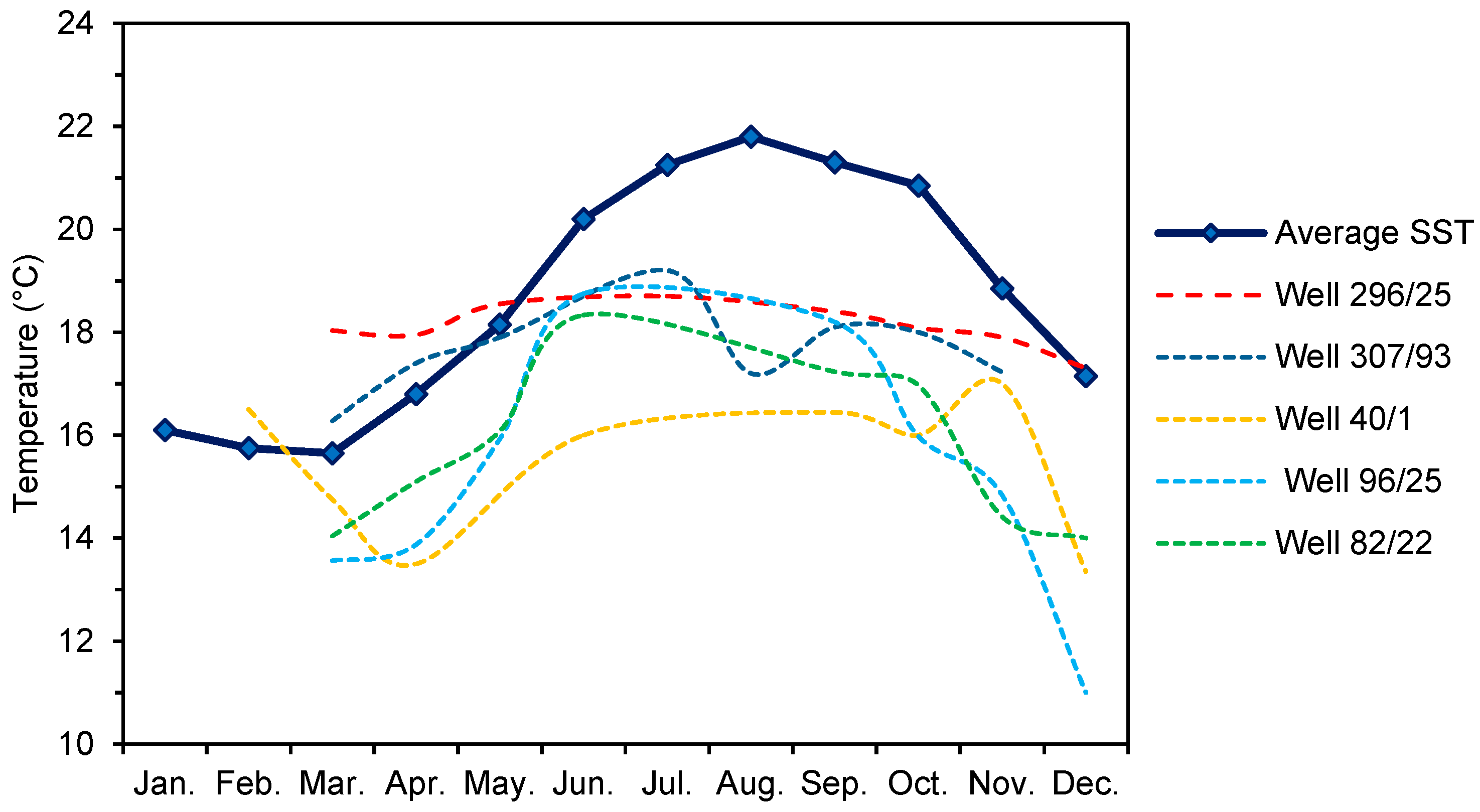
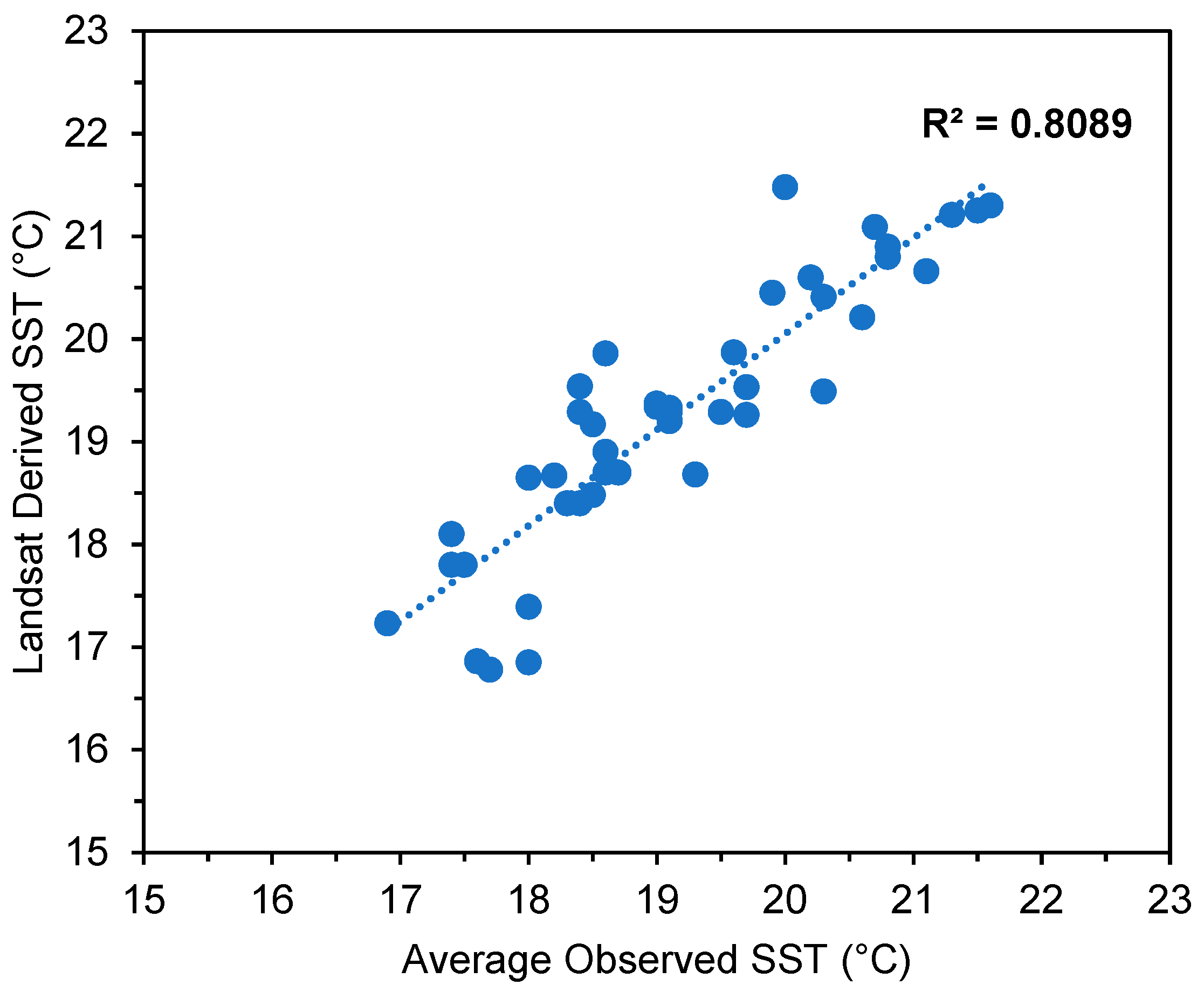

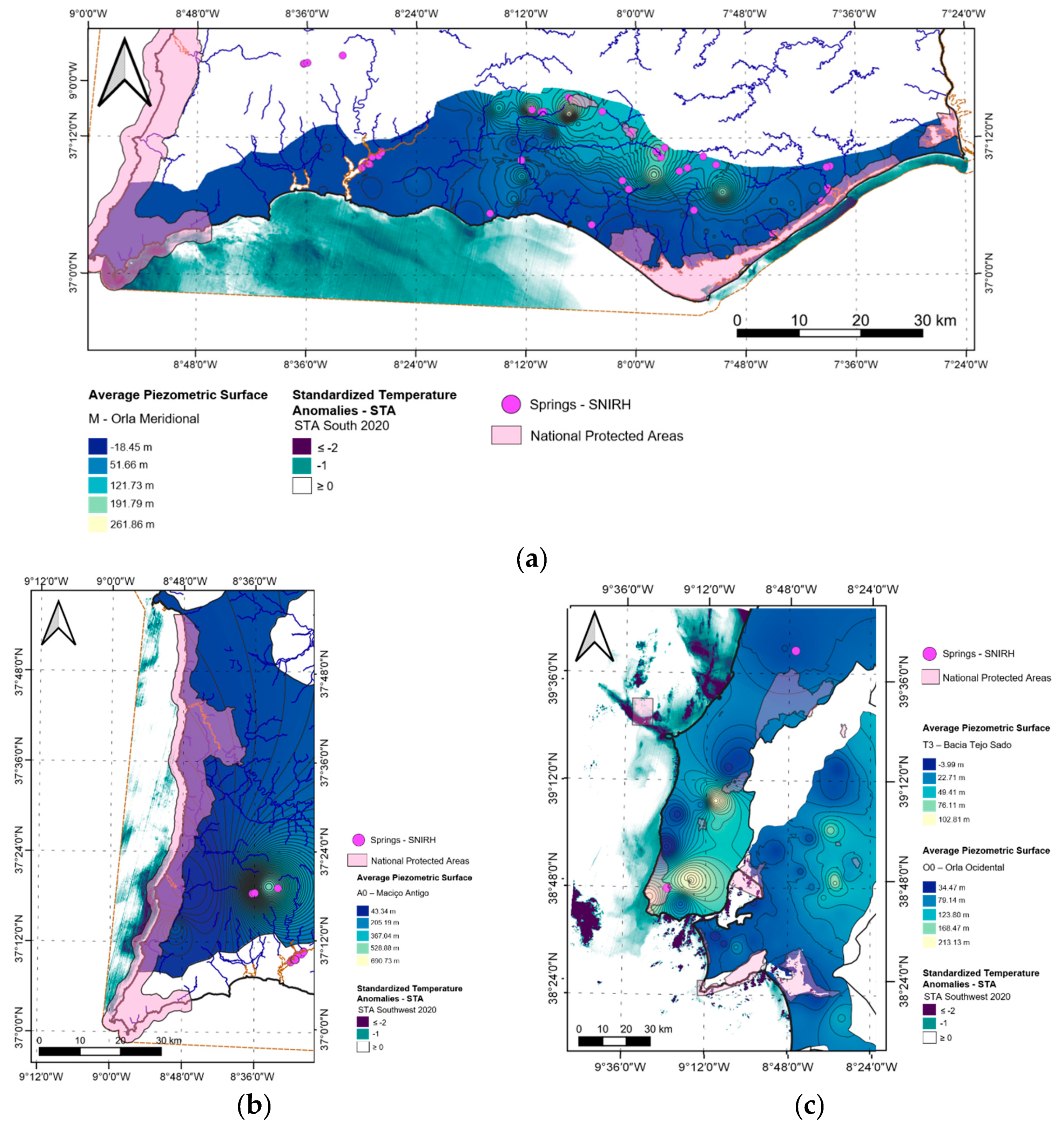
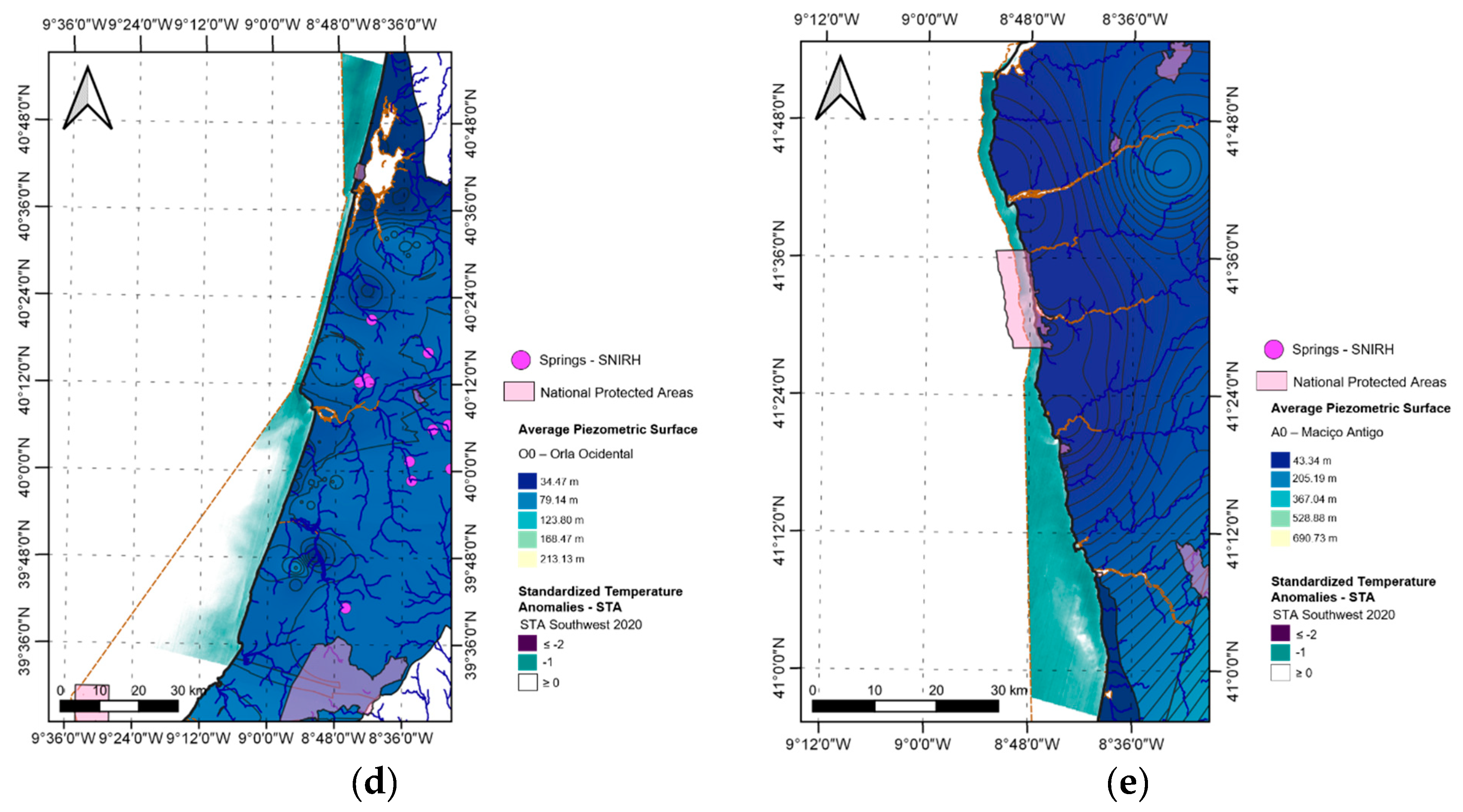
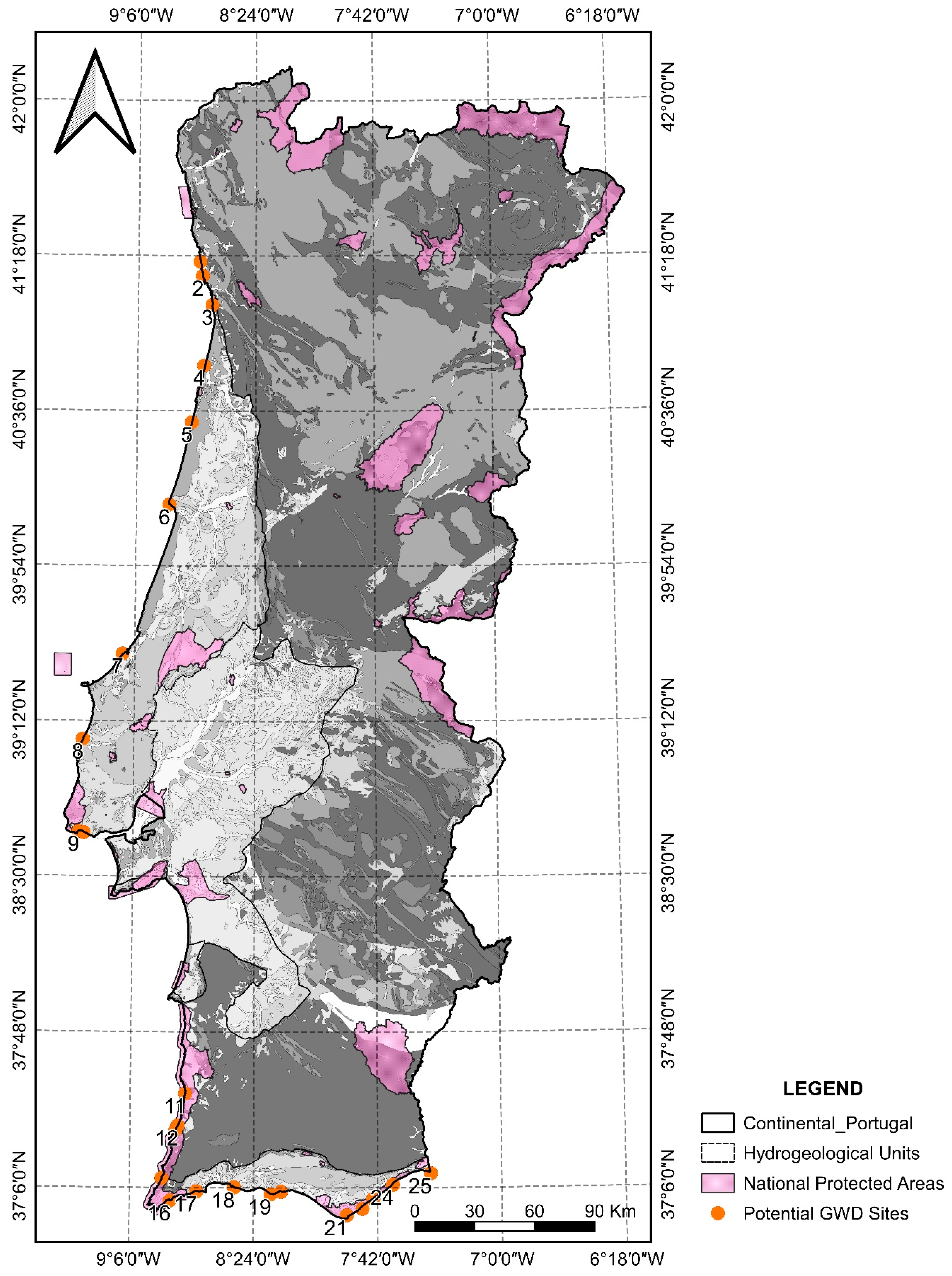
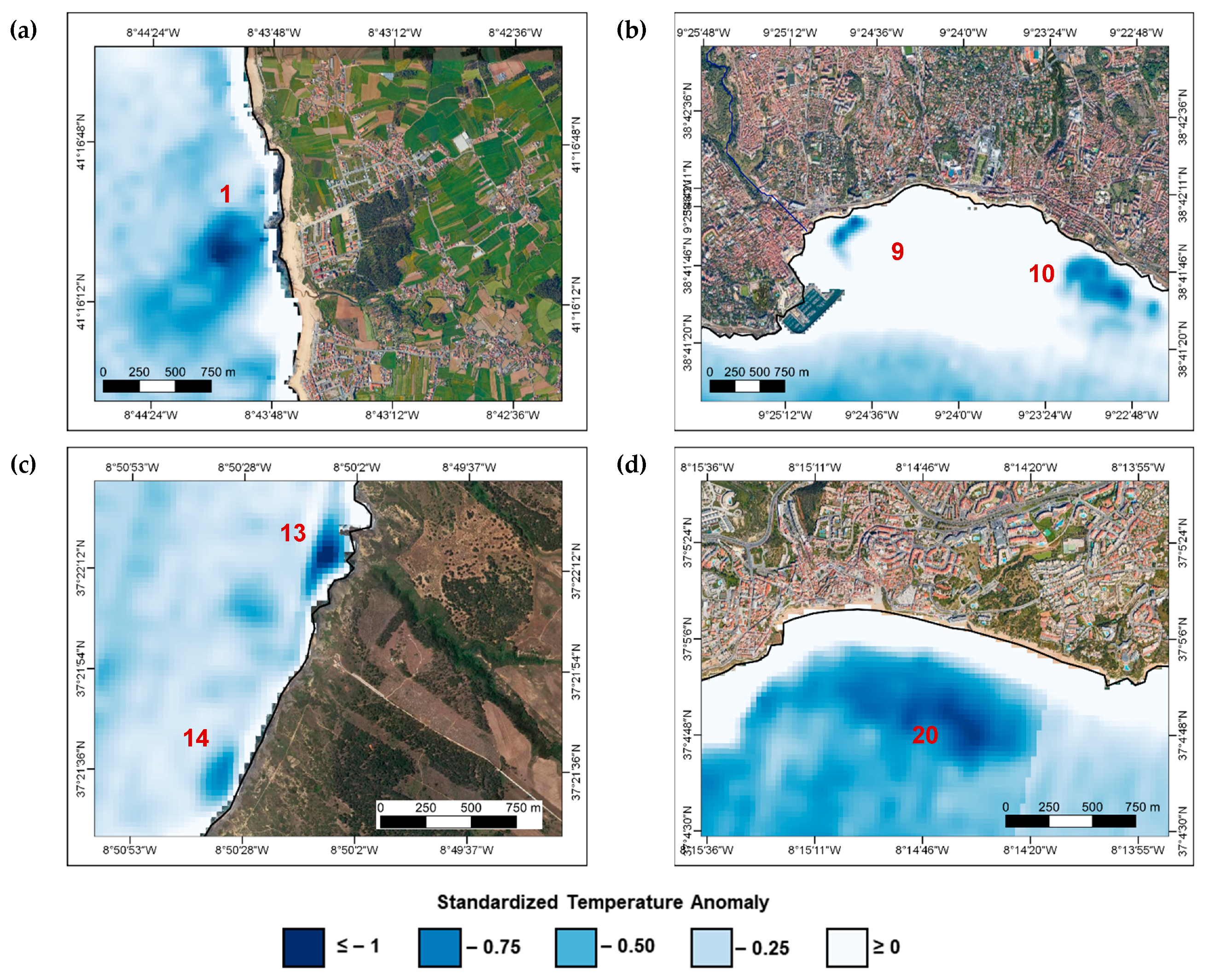
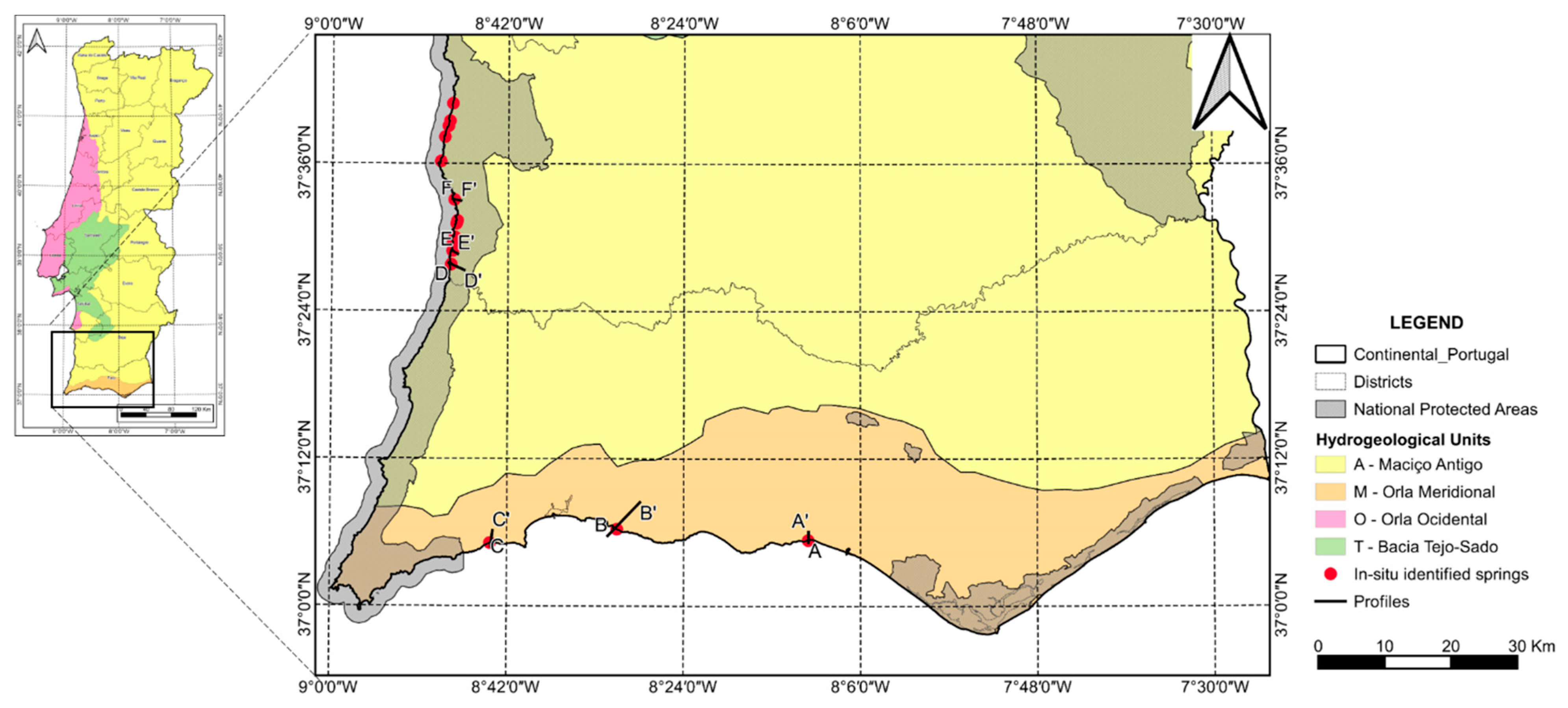
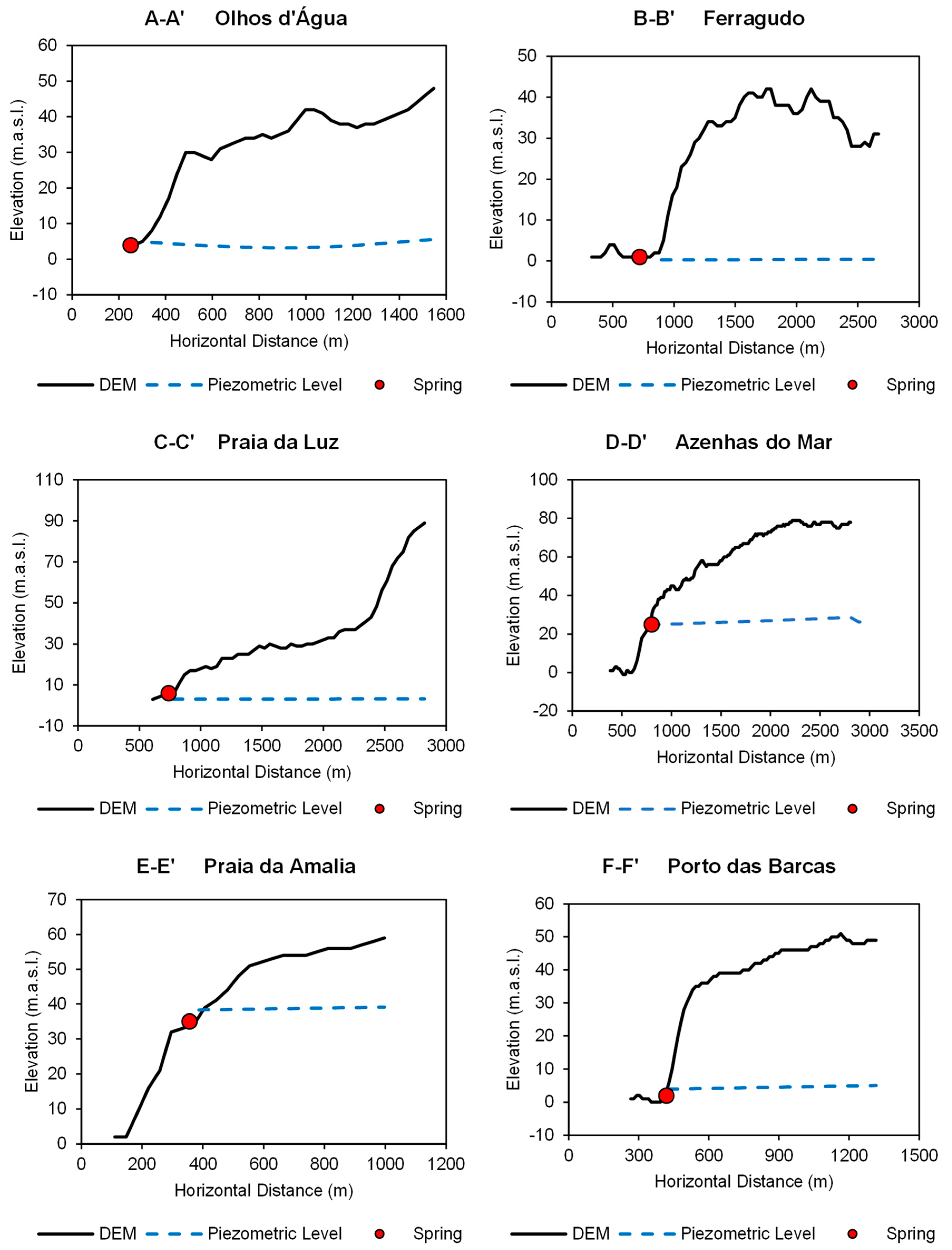
| Coverage Area | Path | Row | Center Latitude | Center Longitude | |
|---|---|---|---|---|---|
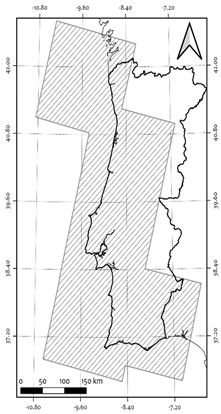 | South | 203 | 34 | 37.4745 | −7.7507 |
| South West | 204 | 34 | 37.4747 | −9.2899 | |
| Center | 204 | 33 | 38.9045 | −8.8684 | |
| North West | 204 | 32 | 40.3326 | −8.4204 | |
| North | 205 | 31 | 41.7596 | −9.5063 |
| Scene Date | Coverage Area | Path | Row | Time | Upwelling W·m−2·sr−1·µm−1 | Downwelling W·m−2·sr−1·µm−1 | Transmission % |
|---|---|---|---|---|---|---|---|
| 19 August 2020 | South | 203 | 34 | 11:09:03 | 1.09 | 1.85 | 0.88 |
| 10 August 2020 | Southwest | 204 | 34 | 11:15:09 | 1.66 | 2.69 | 0.80 |
| 25 July 2020 | Center | 204 | 33 | 11:14:42 | 1.60 | 2.63 | 0.81 |
| 25 July 2020 | Northwest | 204 | 32 | 11:14:18 | 1.53 | 2.52 | 0.82 |
| 16 July 2020 | North | 205 | 31 | 11:20:03 | 1.59 | 2.61 | 0.81 |
| ID | Name | Latitude | Longitude | Hydrogeological Unit | Lithology |
|---|---|---|---|---|---|
| 1 | Praia de Labruge | 41.27360 | −8.73318 | Maciço Antigo | Granites and related rocks |
| 2 | Praia do Aterro | 41.20936 | −8.71803 | Maciço Antigo | Sand and gravels |
| 3 | Praia de Francelos | 41.07932 | −8.66160 | Orla Ocidental | Dunes and eolian sand |
| 4 | Quintas do Norte | 40.80460 | −8.70720 | Orla Ocidental | Dunes and eolian sand |
| 5 | Praia da Duna Alta | 40.54517 | −8.77860 | Orla Ocidental | Dunes and eolian sand |
| 6 | Redondos | 40.16267 | −8.88326 | Orla Ocidental | Conglomerates, sandstones, limestones, dolomitic limestones, loamy limestones, marls |
| 7 | Salir do Porto | 39.50304 | −9.17079 | Orla Ocidental | Conglomerates, sandstones, limestones, dolomitic limestones, loamy limestones, marls |
| 8 | Praia Azul | 39.11729 | −9.39564 | Orla Ocidental | Conglomerates, sandstones, limestones, dolomitic limestones, loamy limestones, marls |
| 9 | Baia de Cascais | 38.69938 | −9.41320 | Orla Ocidental | Sandstones, Conglomerates, limestones, dolomitic limestones, loamy limestones, marls |
| 10 | Sao Joao de Estoril | 38.69500 | −9.38345 | Orla Ocidental | Sandstones, Conglomerates, limestones, dolomitic limestones, loamy limestones, marls |
| 11 | Zambujeira do Mar | 37.52343 | −8.78933 | Maciço Antigo | Clayey shales and schists, greywackes, sandstones |
| 12 | Praia de Vale dos Homes | 37.37861 | −8.83011 | Maciço Antigo | Clayey shales and schists, greywackes, sandstones |
| 13 | Praia de Carriagem | 37.37050 | −8.83593 | Maciço Antigo | Clayey shales and schists, greywackes, sandstones |
| 14 | Praia de Amoreira | 37.35930 | −8.84234 | Maciço Antigo | Alluvium |
| 15 | Praia do Mirouco | 37.14162 | −8.91981 | Maciço Antigo | Clayey shales and schists, greywackes, sandstones |
| 16 | Zavial | 37.04208 | −8.87103 | Orla Meridional | Sedimentary Formation. Conglomerates, sandstones, limestones |
| 17 | Praia da Luz | 37.08306 | −8.72242 | Orla Meridional | Sandstones, Conglomerates, limestones, dolomitic limestones, loamy limestones, marls |
| 18 | Ferragudo | 37.10202 | −8.50998 | Orla Meridional | Sandstones, more or less marly limestone, sand, gravel, clay |
| 19 | Evaristo | 37.07112 | −8.30435 | Orla Meridional | Sandstones, more or less marly limestone, sand, gravel, clay |
| 20 | Albufeira | 37.08242 | −8.24468 | Orla Meridional | Sandstones, more or less marly limestone, sand, gravel, clay |
| 21 | Ilha do Faron Ria Formosa | 36.97688 | −7.87467 | Orla Meridional | Alluvium |
| 22 | Armona | 37.00560 | −7.78606 | Orla Meridional | Alluvium |
| 23 | Fuseta | 37.05151 | −7.72536 | Orla Meridional | Alluvium |
| 24 | Tavira | 37.11274 | −7.61348 | Orla Meridional | Alluvium, Dunes and eolian sand |
| 25 | Santo Antonio | 37.16320 | −7.39936 | Orla Meridional | Alluvium, Dunes and eolian sand |
| Name | Latitude | Longitude | |
|---|---|---|---|
| 1 | Almograve | 37.65083 | −8.80253 |
| 2 | Alteirinhos | 37.51851 | −8.78819 |
| 3 | Carvalhal | 37.50016 | −8.79107 |
| 4 | Ferragudo | 37.10452 | −8.51325 |
| 5 | Foz do Almograve | 37.65772 | −8.80002 |
| 6 | Foz do Barranco do Cavaleiro | 37.60297 | −8.81520 |
| 7 | Lapa de Pombas | 37.63606 | −8.80846 |
| 8 | Porto das Barcas | 37.55092 | −8.79188 |
| 9 | Machados | 37.49146 | −8.79405 |
| 10 | Nascedios A | 37.68144 | −8.79515 |
| 11 | Olhos d’Agua | 37.08953 | −8.18867 |
| 12 | Praia da Amalia | 37.48142 | −8.79476 |
| 13 | Praia da Luz | 37.08550 | −8.72883 |
| 14 | Ribeira da Azenha | 37.46322 | −8.79685 |
| 15 | Zambujeira | 37.52250 | −8.78655 |
Publisher’s Note: MDPI stays neutral with regard to jurisdictional claims in published maps and institutional affiliations. |
© 2022 by the authors. Licensee MDPI, Basel, Switzerland. This article is an open access article distributed under the terms and conditions of the Creative Commons Attribution (CC BY) license (https://creativecommons.org/licenses/by/4.0/).
Share and Cite
Londoño-Londoño, J.E.; Condesso de Melo, M.T.; Nascimento, J.N.; Silva, A.C.F. Thermal-Based Remote Sensing Solution for Identifying Coastal Zones with Potential Groundwater Discharge. J. Mar. Sci. Eng. 2022, 10, 414. https://doi.org/10.3390/jmse10030414
Londoño-Londoño JE, Condesso de Melo MT, Nascimento JN, Silva ACF. Thermal-Based Remote Sensing Solution for Identifying Coastal Zones with Potential Groundwater Discharge. Journal of Marine Science and Engineering. 2022; 10(3):414. https://doi.org/10.3390/jmse10030414
Chicago/Turabian StyleLondoño-Londoño, Julián E., Maria Teresa Condesso de Melo, João N. Nascimento, and Ana C. F. Silva. 2022. "Thermal-Based Remote Sensing Solution for Identifying Coastal Zones with Potential Groundwater Discharge" Journal of Marine Science and Engineering 10, no. 3: 414. https://doi.org/10.3390/jmse10030414
APA StyleLondoño-Londoño, J. E., Condesso de Melo, M. T., Nascimento, J. N., & Silva, A. C. F. (2022). Thermal-Based Remote Sensing Solution for Identifying Coastal Zones with Potential Groundwater Discharge. Journal of Marine Science and Engineering, 10(3), 414. https://doi.org/10.3390/jmse10030414








